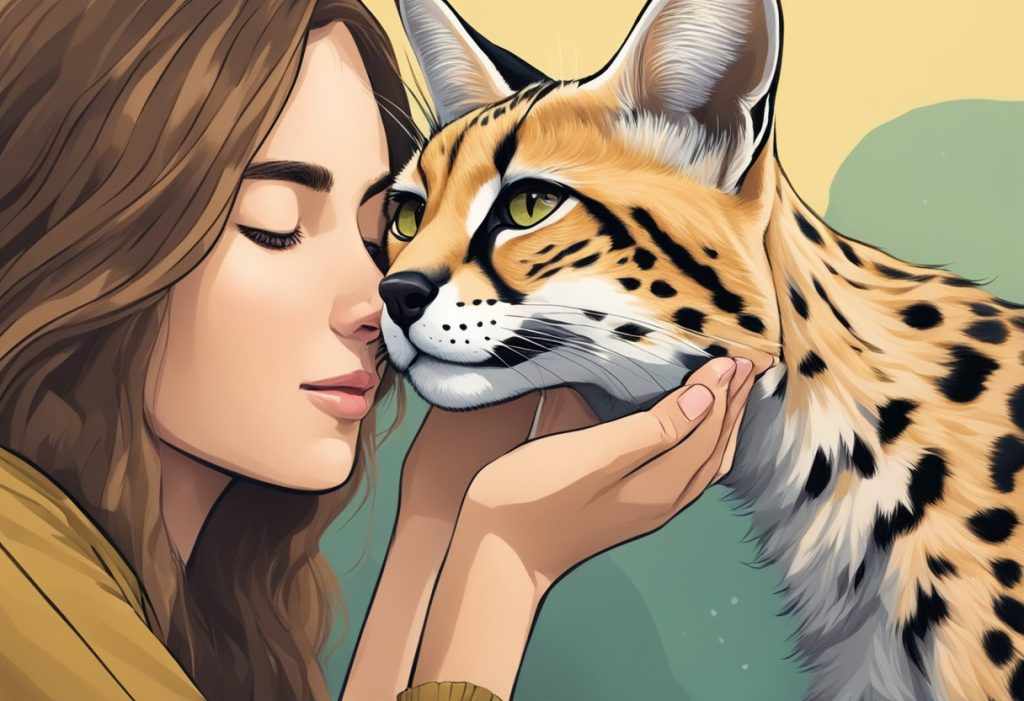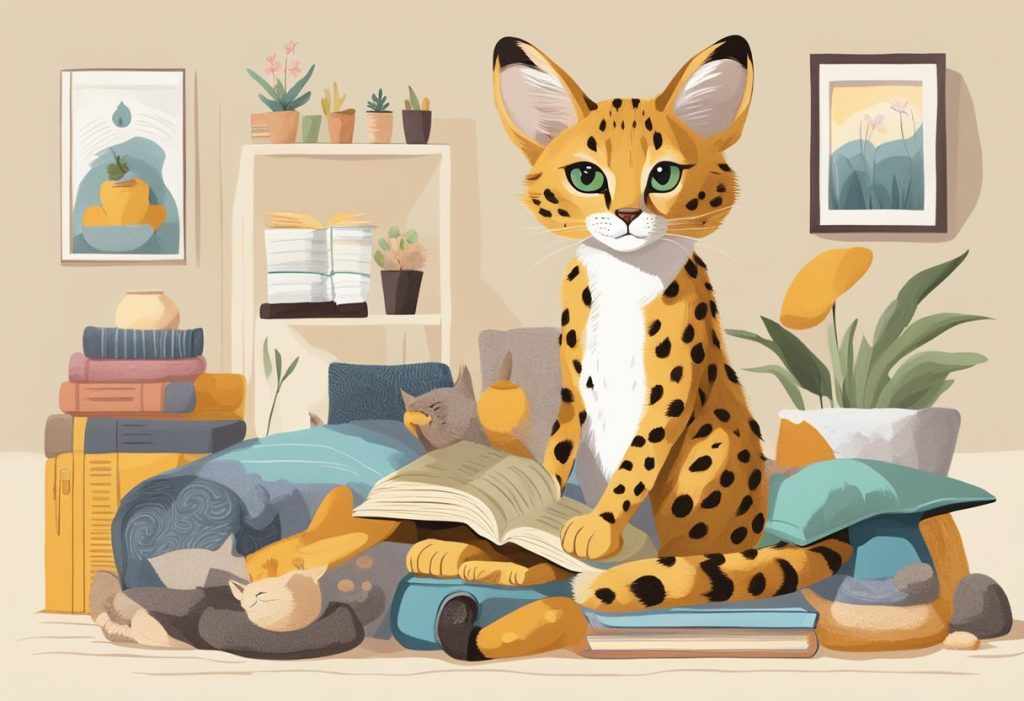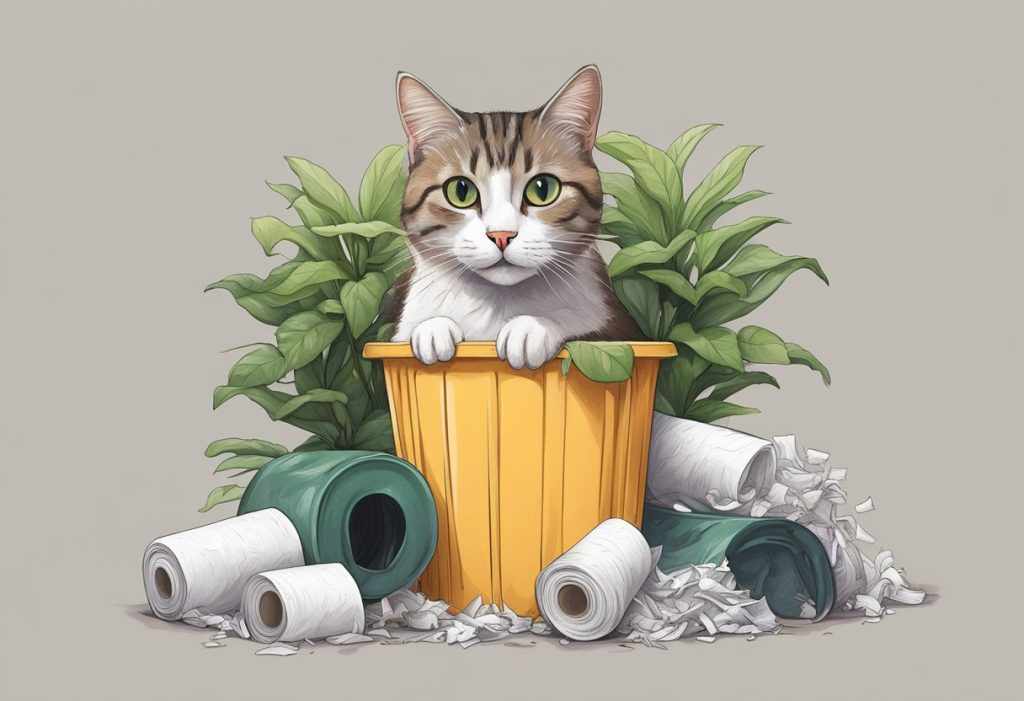Ever wondered about the capabilities of a serval cat when it comes to dealing with humans? Servals are medium-sized African wild cats that stand out with their tall, slender bodies and large, radar-like ears.
They tip the scales at a decent 20 to 40 pounds and possess a height that gives them a perched look at 21 to 24 inches at the shoulder.
Agile jumpers, and servals can easily leap over 6 feet high, a skill they use to pounce on prey in their native tall grasses of sub-Saharan Africa.
Their remarkable hunting abilities are aided by their long legs, the longest among all cat species, which allow them to cover great distances and jump high to catch their prey.
The serval cat (leptailurus serval) is a small to medium-sized wild cat native to various African regions and is known for its ability to deliver a lethal bite to the head or neck of its prey. (1)

Given their prowess, it’s natural to question whether these feline hunters pose a risk to humans. While there are reports of serval cats attacking when they feel threatened, serious injuries to people are rare.
Their native environment is far from our homes, favoring places close to water bodies where they can use their keen hunting skills and agility. (2)
Despite their capability to deliver a fatal bite to smaller creatures, the instances of servals causing significant harm to a human are scarce and often linked to a defensive response rather than predatory aggression, showcasing the nature of serval cats as skilled hunters.
Now, let’s lighten up a bit. Imagine trying to cozy up to a creature that’s just been described as a mini superhero from the wild, the wild serval.
It’s vital to note that wild servals retain their instincts, even in captivity. They’re not your average domesticated tabby and require understanding and respect for their natural behaviors and temperament.
Remember, while servals can be intrigued by humans, considering one as a pet comes with understanding the substantial commitment and responsibility of creating a cat-friendly environment that accommodates their instincts and supporting conservation efforts in their native habitats.
Key Takeaways
- Servals are skilled African wild cats weighing 20-40 pounds with impressive jumping abilities.
- They rarely pose a significant threat to humans and attacks are mostly defensive.
- Understanding and respecting serval behavior is essential for safe interaction.
Understanding Can a Serval Cat Kill a Human? by Cat Behavior
Hey, you’ve probably heard about serval cats, right? These wild felines from Africa are a sight to behold with their lanky legs and speckled coats.
But there’s a big question on some people’s minds: can a serval cat kill a human?
First off, let’s chat about their hunting skills. Servals use those impressive legs to leap high and pounce on their prey.
They’re the Olympians of the cat world, agile and precise in their movements.
But while they’re powerful hunters, typically using their long legs and powerful muscles to catch smaller animals, it is highly unlikely for a human to be on their menu due to their small body size in comparison to their natural habitat in the African grasslands.
Additionally, serval cats are known for their unique coats adorned with black spots and stripes, making them easily recognizable in their habitat.
As for their social life, servals play the lone wolf, err, cat. They prefer living and hunting alone, marking their turf with some distinct scents — sort of like leaving a personal note for other servals to read with their noses.
However, these solitary creatures occasionally form temporary partnerships for cooperative hunting or defense against larger predators. (3)
And unlike the high school dating scene, they mostly hang out with other servals during mating season.
Understanding their social behavior is crucial in understanding the potential danger they may pose to humans.
Now, let’s debunk a cat myth. Even your fluffy house cat isn’t necessarily a loner. Many enjoy a good snuggle with their human pals or furry siblings.
Spot your kitty with a slow blink or a purr? That’s like getting a hug in cat language — it means they’re totally into you! (4)
Oh, and if you see their tail thrash about, that’s not them rocking out — your cat’s probably a bit peeved. It’s like getting the silent treatment but with more flair.
In truth? The chances of a serval cat seriously harming a human are pretty slim. They’re not monstrous creatures from a horror flick but wild animals that deserve respect and space.
So if you cross paths with one, admire them from a distance, and you both should be just fine.
Enhancing Your Relationship with Your Cat

Want to take your bond with your furry friend to the next level? Let’s dive right in and make every purr count!
Building a Stronger Bond
You’ve got that adorable kitty at home, and you’re wondering how to tighten those friendship knots, right? Here’s a nugget you’ll love: the key is quality time.
Just like with your human pals, spending quality time with your cat cultivates a deeper connection.
- Set a playdate: Grab your cat’s favorite toy and initiate a game. Whether it’s a laser pointer or a wand toy, engaging in play sparks joy for both of you.
- Learn their language: Pay attention to your cat’s meows and body language. A slow blink means they trust you — try slow-blinking back! (5)
Avoiding Stress Triggers
Got a jumpy cat? It’s crucial to keep the peace.
- Silence is golden: Keep the noise down — sudden loud sounds can be quite jarring for your little one.
- Stay consistent: Routine is comforting. Consistent feeding and playtimes create a sense of security.
Fostering a Positive Environment
You’re the architect of your cat’s happiness. A few tweaks here and there can make all the difference.
- Toy’s the magic word: From puzzle feeders to rolling balls, toys encourage mental stimulation and physical exercise.
- Scratching posts are a must: It’s their natural behavior, plus it saves your furniture!
By infusing these practices into your daily life, you’re not just a pet owner; you’re a caring companion navigating the path to a lasting friendship with your cat.
Keep the vibes positive, and your kitty’s tail will be happily wagging—or shall we say, flicking—in contentment. Now, go on and create the purr-fect life for you and your feline friend!
Practical Tips for Cat Owners

Let’s dive into some simple yet effective strategies for your domestic cat’s care and management.
Litter Box Mastery: Your kitty’s throne should be nothing short of pristine. Clean their litter box daily to keep your nose happy and prevent any “outside the box” incidents.
Feeding Finesse: A balanced diet keeps your cat purring. Whether they’re a sassy kitten or a graceful senior, match their food to their age and lifestyle for tip-top health.
Health and Well-being:
- Vet Visits: Regular check-ups? Crucial! Make an annual vet date to keep vaccinations and health screening on track. It’s like taking your car for a tune-up but furrier and much cuter. (6)
Mental Gymnastics: Keep that cat brain buff with puzzle feeders and swanky cat trees! It’s like a jungle gym for their mind, mimicking the wild and keeping them mentally tickled.
Remember, a watched pot never boils, but a watched cat always thrives. Your care and watchful eye make all the difference. Here’s to happy, healthy kitties! 🐾
Responsible Cat Ownership

Have you ever considered the adventure of having a serval cat as a pet? While they’re majestic and fascinating creatures, they come with a bundle of responsibilities.
Let’s chat about what it means to be a responsible serval cat owner.
Firstly, it’s essential to ask yourself, are you legally allowed to own a serval cat where you live?
These exotic cats aren’t your average household pet, and many places require special licenses or permits to have them, including several states in the United States.
It’s not just a formality; it’s about being a law-abiding animal lover. Research your local laws and regulations, including those in the UK, to stay on the right side of the fence. (7)
- Legal Requirements:
- Check for necessary permits
- Understand local wildlife regulations
If you find hoops and hurdles on the legal side of things, don’t feel disheartened. Why not consider a furry friend that needs a home?
Domestic cats are overflowing in animal shelters and they are just waiting to be a part of your family. It’s a purr-fect alternative to exotic pets!
- Shelters:
- Homes for domestic cats
- Adoption over exotic ownership
Remember, owning a serval cat isn’t a walk in the park. Sure, they’ve got a kill rate in the wild that’s impressive, but that’s where they shine.
Your job, should you choose to accept the challenge, is to create a nurturing environment that honors their wild nature while ensuring safety for both you and your unique companion.
This includes providing a variety of meats in their diet, such as chicken, turkey, beef, and smaller prey like mice, rats, and chicks, to mimic their natural diet in the wild.
Additionally, responsible cat ownership means understanding the needs of your serval cat and providing appropriate enclosures for their well-being.
This includes wide outdoor enclosures for their intense energy and need to roam, as well as secure fencing to prevent escape attempts.
- Responsible Ownership:
- The safe and nurturing environment
- Balance between wild instincts and domestic safety
So, before you jump into the exotic pet world, take a moment to consider your choices.
Perhaps you’ll find joy in giving a loving, forever home to a cozy kitty from the shelter. Your heart (and the local wildlife authorities) will thank you for it!
Creating a Cat-friendly Home

Creating a cat-friendly home takes a pinch of creativity and a dash of love.
Safe Havens Who doesn’t crave a little me-time? Your cat sure does! Set up cozy nooks where your furry pal can snooze or just get away from it all.
Think of soft bedding and a bit of privacy—like a mini vacation spot within your living space.
- Under the bed – a secretive spot for a serene retreat.
- Window perch – for a captivating view of the outside world.
- Shelf hideaways – elevated spots to keep an eye on their kingdom.
Fun and Games Let’s turn your home into a cat’s adventure park! Mix and match textures for bedding and toys—wool, cotton, or even a crinkly tunnel. Keep those kitty senses keen!
- Textured toys – to keep those paws busy.
- Scratching posts – better your furniture thanks to it.
- Interactive gadgets – because who doesn’t love a good laser chase?
Remember, a happy cat is a friendly cat. So, by catering to their instincts, you’ll ensure both their well-being and a harmonious home.
And who knows? A content cat might just be your best bet at warding off unwelcome rodents, making your cat-friendly home a practical fortress too!
Humor and Relatability in Cat Ownership

Cat owners worldwide know all too well the “midnight zoomies”—that sudden burst of energy that has your cat sprinting from room to room like a racecar.
Why do they do it? Well, it’s just one of the many endearing quirks that make owning a cat a blend of comedy and chaos. When it’s not the zoomies, it’s the box obsession.
Isn’t it funny how your feline friend will choose a cardboard box over the expensive cat bed you bought?
- Is box too small? No problem.
- A tight lid? Better challenge.
Cats are the ultimate puzzle solvers, determined to make themselves fit in any box, regardless of size.
Cats can be peculiar with their preferences, can’t they? One day they love the salmon treats, and the next, they’ve decided that a piece of plain old white bread is the pinnacle of fine dining.
But, despite these whims, you can’t help but love them. Each quirk, each unpredictable choice, brings a sense of joy and laughter into our lives.
And let’s not forget their love language – the head bop, a swift leap onto our laps, and the unexpected “gifts” they bring.
Each action, though sometimes peculiar, is a reminder of the unique bond shared between cats and their humans.
It’s through these shared moments of humor that our love for our quirky companions grows stronger.
So keep enjoying those midnight races and the laughable love of the box; it’s all part of the wonderful world of cat ownership!
Quick Recap

Well, it’s certainly worth discussing whether a serval cat could, in an extreme scenario, pose a lethal threat to humans. First off, servals are indeed capable hunters, known to take down prey much larger than themselves.
However, bringing a hybrid pet like a serval cat into your life should involve the same thoughtful consideration as adopting or purchasing a truly domesticated animal such as several cats.
In short, we cover the question, can a serval cat kill a human?
With captivating images featuring leopards and various majestic feline creatures, it’s evident that hybrid animal breeds are fueling our creative thoughts.
Now, let’s get down to the nitty-gritty. While a serval cat attacking a human is exceptionally rare, it’s not entirely out of the question.
These cats are wild animals with powerful limbs and sharp teeth, as seen in the case of a 4-year-old boy in New York who was bitten by a 40-pound African serval called Copper while he was being taken for a walk and had to undergo plastic surgery.
However, here’s the thing: cases where servals have caused serious injuries to humans, especially toddlers, are pretty scarce. It’s so uncommon that you’re more likely to win a dance-off with your house cat!
To put things into perspective:
- Size & Weight: Servals measure about 20-25 inches at the shoulder and weigh 20-40 pounds.
- Human Interactions: They’re shy by nature and typically keep their distance from us two-legged creatures.
- History of Attacks: There have been incidents of serval aggressions leading to injuries, such as a case in Florida back in 2001 involving a child.
And as for our furry canine friends, serval attacks on dogs have indeed occurred. That said, these instances seem to be when the serval feels cornered or threatened.
So, while you cherish the bond with your whiskered roomie, it’s captivating to learn about their undomesticated relatives. Just remember, it’s all about respect and understanding the boundaries of wildlife.
Keep that in mind, and you’ll both be purring in no time!
Frequently Asked Questions

In this section, we’ll answer some of the top questions regarding serval cats, focusing on their potential risks, behavior, and considerations for ownership.
You’ll find concise answers to help you understand what it’s like living with these exotic animals.
Can a Serval Cat Kill a Human?
While serval cats are capable predators, attacks on humans are rare and fatalities even rarer.
Their weight of 20-40 pounds means they’re strong enough to harm small animals but killing a human is highly unlikely.
Always remember, that respect and caution are key when interacting with any wild animal.
How Do I Interpret My Cat’s Body Language?
Your cat’s body language can reveal a lot about its mood. For instance, an arched back and fluffed-up tail suggest fear or aggression.
Look for relaxed postures and slow blinks, which often indicate trust and contentment. Understanding these cues can strengthen your bond.
What Are the Legal Considerations for Owning a Serval Cat?
Owning a serval cat comes with strict regulations. They’re considered exotic pets and are illegal in some places.
Always check your local laws and remember that special permits and housing requirements often apply, ensuring the safety of both the cat and the community.
How Can I Improve My Relationship with My Cat?
To improve your relationship with your cat, invest time in interactive play, and offer consistent, gentle attention.
Learn what treats and toys your cat prefers and provide them regularly. Trust and affection grow from routine and positive interactions.
What Are Some Effective Ways to Correct Unwanted Cat Behaviors?
Correcting unwanted behaviors in cats should involve positive reinforcement rather than punishment. Reward good behavior with treats or praise.
If behavioral issues persist, consult a veterinarian or a cat behaviorist for tailored advice.
Are Serval Cats Dangerous to Other Pets?
Due to their hunting instincts, serval cats might view small pets as prey, posing a potential danger.
With larger dogs, a serval might feel threatened and act defensively. It’s important to supervise interactions closely and provide proper introductions.
- Advantages of Playing Casino Online - July 6, 2025
- How players can take advantage of the no deposit bonus at the Casino - July 5, 2025


